
|
Now it is 10.7 mag (Dec. 18, Osamu Miyazaki). It will turn to fade out rapidly after the peak. In the Northern Hemisphere, it stays observable in good condition. In the Southern Hemisphere, it will be getting higher gradually.
Date(TT) R.A. (2000) Decl. Delta r Elong. m1 Best Time(A, h)
Dec. 20 11 52.93 16 43.1 0.609 1.211 96 8.7 5:32 (341, 71)
Dec. 27 12 26.53 15 24.7 0.597 1.195 95 8.4 5:36 (340, 69)
|

|
It was originally expected to brighten up to 5 mag in January. But actually, the brightness evolution is slower than originally expected. It will be 8 mag at best. Now it is 9.6 mag (Dec. 10, Mike Olason). It brightens up to 7.5 mag, but it will turn to fade out rapidly after that. Now it is not observable. It will appear in January in the Southern Hemisphere, or in February in the Northern Hemisphere.
Date(TT) R.A. (2000) Decl. Delta r Elong. m1 Best Time(A, h)
Dec. 20 18 25.75 -18 13.8 1.849 0.894 9 10.0 18:22 ( 73, -9)
Dec. 27 18 47.03 -22 47.9 1.760 0.788 5 9.5 18:26 ( 71,-13)
|
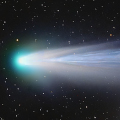
|
It brightened up to 3.7 mag in late October (Oct. 26, Juan Jose Gonzalez). Fading rapidly. Now it is not observable. It will appear soon in the Southern Hemisphere.
Date(TT) R.A. (2000) Decl. Delta r Elong. m1 Best Time(A, h)
Dec. 20 17 12.33 -35 13.9 1.967 1.044 14 10.3 5:32 (302,-17)
Dec. 27 17 12.13 -37 39.5 2.027 1.161 20 11.0 5:36 (307,-13)
|

|
Now it is 9.8 mag (Dec. 18, Osamu Miyazaki). It will fade out rapidly after this. In the Northern Hemisphere, it will be unobservable in January. In the Southern Hemisphere, it is not observable now, but it will appear in March.
Date(TT) R.A. (2000) Decl. Delta r Elong. m1 Best Time(A, h)
Dec. 20 20 13.48 5 56.4 1.595 1.145 45 10.7 18:22 ( 77, 27)
Dec. 27 20 28.46 1 31.5 1.758 1.179 39 11.2 18:26 ( 76, 21)
|
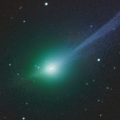
|
Third interstellar object in history following 1I/'Oumuamua and 2I/Borisov. The eccentricity is extremely big as 6. It approached to Sun down to 1.38 a.u. in late October. It brightened up to 8.9 mag in November (Nov. 12, Toshiyuki Takahashi). Now it is 11.2 mag (Dec. 18, Osamu Miyazaki). Fading rapidly. It will be fainter than 18 mag in March. It stays observable in good condition.
Date(TT) R.A. (2000) Decl. Delta r Elong. m1 Best Time(A, h)
Dec. 20 10 42.57 7 23.8 1.798 2.309 108 11.8 4:50 ( 0, 62)
Dec. 27 10 9.07 10 7.0 1.825 2.516 124 12.4 3:49 ( 0, 65)
|
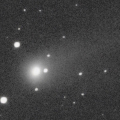
|
It brightened up to 9.5 mag in late November (Nov. 28, Michael Jager, Gerald Rhemann, E. Prosperi). Now it is 11.6 mag (Dec. 18, Osamu Miyazaki). Fading rapidly. It will be fainter than 18 mag in March. It will be getting higher gradually.
Date(TT) R.A. (2000) Decl. Delta r Elong. m1 Best Time(A, h)
Dec. 20 14 45.22 -8 32.2 0.950 0.770 46 11.9 5:32 (303, 26)
Dec. 27 14 57.82 -8 28.8 1.032 0.870 51 12.8 5:36 (307, 29)
|

|
Now it is 12.1 mag (Dec. 16, Osamu Miyazaki). Fading gradually. In the Northern Hemisphere, it stays observable in good condition. In the Southern Hemisphere, it will be getting lower gradually. The component B is brightening rapidly. Now it is bright as 14.3 mag (Dec. 7, Andrew Pearce).
Date(TT) R.A. (2000) Decl. Delta r Elong. m1 Best Time(A, h)
Dec. 20 3 22.83 13 1.2 1.249 2.122 143 12.2 21:26 ( 0, 68)
Dec. 27 3 19.79 14 50.8 1.300 2.122 136 12.3 20:56 ( 0, 70)
|

|
Brightening gradually. It stays extremely low in the Northern Hemisphere. But it will become high in summer. In the Southern Hemisphere, it is not observable now, but it will appear in January.
Date(TT) R.A. (2000) Decl. Delta r Elong. m1 Best Time(A, h)
Dec. 20 16 14.63 -21 0.9 2.524 1.658 22 12.5 5:32 (297, 2)
Dec. 27 16 36.49 -22 1.5 2.462 1.618 24 12.3 5:36 (299, 3)
|
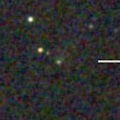
|
It became brighter than expected. Now it is 13.5 mag (Nov. 29, Ken-ichi Kadota). It stays 13 mag for a while. It locates somewhat low in the Northern Hemisphere. But it will become high in spring. In the Southern Hemisphere, it will be getting higher gradually.
Date(TT) R.A. (2000) Decl. Delta r Elong. m1 Best Time(A, h)
Dec. 20 14 8.48 -14 18.4 2.405 1.978 53 13.3 5:32 (315, 27)
Dec. 27 14 24.29 -15 13.6 2.345 1.978 56 13.2 5:36 (319, 29)
|

|
It brightened up to 5.2 mag in October (Oct. 11, Virgilio Gonano). Now it is 12.9 mag (Dec. 18, Toru Yusa). Fading rapidly. It will be fainter than 18 mag in March. In the Northern Hemisphere, it stays observable in good condition. It locates somewhat low in the Southern Hemisphere.
Date(TT) R.A. (2000) Decl. Delta r Elong. m1 Best Time(A, h)
Dec. 20 0 41.76 10 35.2 1.441 1.952 105 13.3 18:46 ( 0, 66)
Dec. 27 0 52.59 11 23.4 1.622 2.055 101 13.8 18:30 ( 0, 67)
|

|
Now it is 13.0 mag (Dec. 16, Osamu Miyazaki). Fading slowly. In the Northern Hemisphere, it stays observable in good condition. It locates somewhat low in the Southern Hemisphere.
Date(TT) R.A. (2000) Decl. Delta r Elong. m1 Best Time(A, h)
Dec. 20 3 12.36 24 58.2 3.184 4.021 143 13.6 21:16 ( 0, 80)
Dec. 27 3 11.82 24 45.5 3.267 4.040 136 13.6 20:48 ( 0, 80)
|

|
It brightened up to 9.3 mag in November (Nov. 2, Virgilio Gonano). Now it is 12.6 mag (Dec. 11, Osamu Miyazaki). Fading rapidly. It will be fainter than 18 mag in February. In the Northern Hemisphere, it stays observable in good condition. In the Southern Hemisphere, it will be unobservable in February. The nucleus is split into three components.
Date(TT) R.A. (2000) Decl. Delta r Elong. m1 Best Time(A, h)
Dec. 20 1 2.34 44 57.9 0.929 1.645 118 13.7 19:06 (180, 80)
Dec. 27 0 57.68 40 20.1 1.147 1.762 111 14.5 18:34 (180, 85)
|
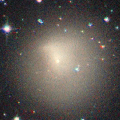
|
It brightened in outburst on Dec. 5. Now it is 12.6 mag (Dec. 18, Osamu Miyazaki). It stays observable in good condition.
Date(TT) R.A. (2000) Decl. Delta r Elong. m1 Best Time(A, h)
Dec. 20 11 33.25 -2 54.0 6.177 6.305 92 14.0 5:32 (357, 52)
Dec. 27 11 34.10 -3 9.9 6.064 6.306 99 13.9 5:13 ( 0, 52)
|
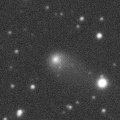
|
Now it is 14.4 mag (Nov. 29, Purple Mountain Observatory, XuYi Station). It stays 15 mag for a while. In the Northern Hemisphere, it stays observable in good condition. It locates somewhat low in the Southern Hemisphere.
Date(TT) R.A. (2000) Decl. Delta r Elong. m1 Best Time(A, h)
Dec. 20 9 27.03 23 7.9 4.832 5.525 130 14.3 3:34 ( 0, 78)
Dec. 27 9 26.47 23 50.7 4.762 5.532 137 14.3 3:06 ( 0, 79)
|
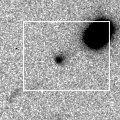
|
It is expected to brighten up to 13.5 mag and to be observable in good condition in 2026 spring. Brightening slowly. In the Northern Hemisphere, it is not observable now, but it will appear in January. In the Southern Hemisphere, it will be getting higher gradually.
Date(TT) R.A. (2000) Decl. Delta r Elong. m1 Best Time(A, h)
Dec. 20 15 33.51 -40 39.0 2.440 1.709 33 14.8 5:32 (318, -5)
Dec. 27 15 40.36 -38 50.1 2.364 1.694 37 14.7 5:36 (320, 0)
|

|
Now it is 14.4 mag (Oct. 11, Hiroshi Abe). It stays 15 mag for a while. In the Northern Hemisphere, it will be getting higher gradually. In the Southern Hemisphere, it is not observable now, but it will appear in January.
Date(TT) R.A. (2000) Decl. Delta r Elong. m1 Best Time(A, h)
Dec. 20 16 40.78 -0 21.6 6.951 6.107 28 14.8 5:32 (277, 9)
Dec. 27 16 46.22 -0 3.1 6.938 6.136 32 14.8 5:36 (280, 14)
|
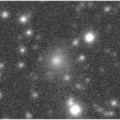
|
It will brighten up to 13 mag in 2026. Now it is 14.9 mag (Nov. 17, Alfons Diepvens). It stays 14 mag for a while. In the Northern Hemisphere, it will be unobservable temporarily in January. In the Southern Hemisphere, it is not observable now, but it will appear in February.
Date(TT) R.A. (2000) Decl. Delta r Elong. m1 Best Time(A, h)
Dec. 20 19 6.19 -5 33.8 5.712 4.842 25 14.8 18:22 ( 78, 7)
Dec. 27 19 11.22 -4 51.0 5.706 4.807 21 14.8 18:26 ( 83, 2)
|
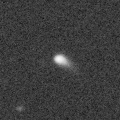
|
Now it is 14.5 mag (Dec. 15, ATLAS Chile). It stays 14 mag for a while. In the Northern Hemisphere, it will be unobservable in March. In the Southern Hemisphere, it stays observable in good condition. It is expected to brighten up to 11 mag in winter between 2026 and 2027.
Date(TT) R.A. (2000) Decl. Delta r Elong. m1 Best Time(A, h)
Dec. 20 2 38.88 -42 47.5 5.457 5.716 100 14.8 20:42 ( 0, 12)
Dec. 27 2 37.01 -41 48.0 5.477 5.676 96 14.8 20:13 ( 0, 13)
|
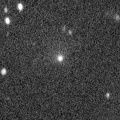
|
Very large comet. It is expected to brighten up to 13 mag in 2031. Now it is 14.3 mag (Nov. 22, Thomas Lehmann). It stays 15 mag for a while. In the Northern Hemisphere, it is not observable now. In the Southern Hemisphere, it stays observable in good condition. In the Northern Hemisphere, it is not observable until 2030.
Date(TT) R.A. (2000) Decl. Delta r Elong. m1 Best Time(A, h)
Dec. 20 5 7.71 -74 57.8 14.551 14.436 81 14.9 23:08 ( 0,-20)
Dec. 27 5 2.72 -74 54.3 14.537 14.414 80 14.9 22:36 ( 0,-20)
|

|
It will brighten up to 12 mag in 2026 summer. Now it is 16.3 mag (Dec. 14, Catalina Sky Survey). Brightening gradually. It will be unobservable in January in the Southern Hemisphere, or in February in the Northern Hemisphere.
Date(TT) R.A. (2000) Decl. Delta r Elong. m1 Best Time(A, h)
Dec. 20 21 17.56 -11 19.2 2.998 2.489 50 15.1 18:22 ( 51, 27)
Dec. 27 21 29.05 -10 37.0 3.035 2.460 46 15.0 18:26 ( 56, 25)
|
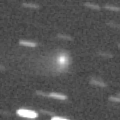
|
Now it is 15.3 mag (Dec. 4, Ken-ichi Kadota). It stays 15 mag for a while. In the Northern Hemisphere, it will be unobservable temporarily in January. In the Southern Hemisphere, it is not observable now, but it will appear in February.
Date(TT) R.A. (2000) Decl. Delta r Elong. m1 Best Time(A, h)
Dec. 20 19 17.54 -1 4.1 4.531 3.718 30 15.3 18:22 ( 80, 12)
Dec. 27 19 19.49 -1 33.8 4.562 3.701 25 15.3 18:26 ( 84, 5)
|
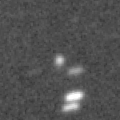
|
Brightening rapidly. It is expected to brighten up to 12 mag from 2027 to 2028. Now it is 16.0 mag (Nov. 17, Alfons Diepvens). It stays 16 mag for a while. In the Northern Hemisphere, it will be getting lower gradually. But it will be getting higher again after February. In the Southern Hemisphere, it is not observable now, but it will appear in April.
Date(TT) R.A. (2000) Decl. Delta r Elong. m1 Best Time(A, h)
Dec. 20 21 30.47 20 57.5 7.166 6.882 69 15.9 18:22 ( 81, 51)
Dec. 27 21 31.96 21 0.9 7.217 6.844 64 15.9 18:26 ( 86, 45)
|
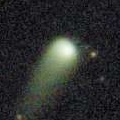
|
It was observed at 12-13 mag for a long time in 2024. Now it is 15.8 mag (Dec. 10, Ken-ichi Kadota). Fading slowly. In the Northern Hemisphere, it will be getting lower gradually. But it will be getting higher again after March. In the Southern Hemisphere, it is not observable now, but it will appear in April.
Date(TT) R.A. (2000) Decl. Delta r Elong. m1 Best Time(A, h)
Dec. 20 22 27.67 33 46.8 5.375 5.415 87 16.0 18:22 ( 95, 67)
Dec. 27 22 28.87 32 40.9 5.520 5.457 81 16.1 18:26 ( 96, 61)
|
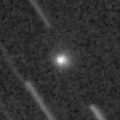
|
Now it is 15.6 mag (Dec. 10, Hidenori Nohara). Fading slowly. In the Northern Hemisphere, it will be getting lower gradually after this, and it will be unobservable in March. In the Southern Hemisphere, it stays observable in good condition.
Date(TT) R.A. (2000) Decl. Delta r Elong. m1 Best Time(A, h)
Dec. 20 2 15.58 -0 21.5 1.570 2.257 122 16.1 20:19 ( 0, 54)
Dec. 27 2 9.42 -4 5.3 1.659 2.230 112 16.1 19:45 ( 0, 51)
|

|
Now it is 16.2 mag (Dec. 15, ATLAS South Africa). It stays 16 mag for a while. It stays observable in good condition.
Date(TT) R.A. (2000) Decl. Delta r Elong. m1 Best Time(A, h)
Dec. 20 8 56.72 -11 49.3 6.030 6.612 122 16.1 3:03 ( 0, 43)
Dec. 27 8 55.20 -11 34.4 5.956 6.617 128 16.1 2:34 ( 0, 43)
|

|
Now it is 15.4 mag (Dec. 4, Ken-ichi Kadota). It stays 17 mag for a while. In the Southern Hemisphere, it will be getting higher gradually.
Date(TT) R.A. (2000) Decl. Delta r Elong. m1 Best Time(A, h)
Dec. 20 14 50.13 -7 25.3 2.404 1.864 46 16.5 5:32 (301, 26)
Dec. 27 15 7.20 -8 19.2 2.372 1.880 49 16.5 5:36 (305, 28)
|

|
Now it is 16.2 mag (Dec. 17, Yukihiro Sugiyama). It stays 16 mag for a while. In the Northern Hemisphere, it stays observable in good condition. In the Southern Hemisphere, it is not observable now.
Date(TT) R.A. (2000) Decl. Delta r Elong. m1 Best Time(A, h)
Dec. 20 9 27.47 79 13.0 3.329 3.908 119 16.5 3:37 (180, 46)
Dec. 27 8 33.91 79 43.0 3.274 3.883 121 16.5 2:18 (180, 45)
|

|
Now it is 16.2 mag (Dec. 17, Yukihiro Sugiyama). It stays 17 mag for a while. In the Northern Hemisphere, it stays observable in good condition. In the Southern Hemisphere, it will be unobservable in April.
Date(TT) R.A. (2000) Decl. Delta r Elong. m1 Best Time(A, h)
Dec. 20 4 37.78 53 37.8 2.965 3.826 146 16.5 22:41 (180, 71)
Dec. 27 4 32.40 53 19.4 2.989 3.825 143 16.5 22:08 (180, 72)
|
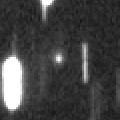
|
Now it is 16.2 mag (Dec. 14, Catalina Sky Survey). Fading slowly. It will be fainter than 18 mag in April. It will be unobservable in February in the Southern Hemisphere, or in April in the Northern Hemisphere.
Date(TT) R.A. (2000) Decl. Delta r Elong. m1 Best Time(A, h)
Dec. 20 22 0.25 -7 4.0 2.284 2.015 61 16.5 18:22 ( 44, 37)
Dec. 27 22 14.50 -5 45.5 2.346 2.014 58 16.5 18:26 ( 50, 36)
|
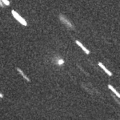
|
Now it is 16.5 mag (Dec. 2, ATLAS Chile). It stays 17 mag for a while. In the Northern Hemisphere, it stays observable in good condition. In the Southern Hemisphere, it will be getting lower gradually after this, and it will be unobservable in March.
Date(TT) R.A. (2000) Decl. Delta r Elong. m1 Best Time(A, h)
Dec. 20 23 16.47 -6 46.7 1.852 1.931 79 16.5 18:22 ( 22, 46)
Dec. 27 23 28.00 -4 48.4 1.909 1.918 75 16.5 18:26 ( 30, 46)
|

|
Now it is 16.2 mag (Dec. 18, D. Buczynski). Fading slowly. In the Northern Hemisphere, it stays observable in good condition. In the Southern Hemisphere, it will be unobservable soon.
Date(TT) R.A. (2000) Decl. Delta r Elong. m1 Best Time(A, h)
Dec. 20 8 36.62 52 14.6 3.432 4.209 137 16.5 2:44 (180, 73)
Dec. 27 8 27.51 54 28.6 3.423 4.233 141 16.5 2:08 (180, 71)
|

|
It brightened up to 12.7 mag in 2024 summer (Aug. 7, 2024, Thomas Lehmann). Now it is 15.9 mag (Dec. 13, Alfons Diepvens). Fading slowly. It will be fainter than 18 mag in April. In the Northern Hemisphere, it stays observable in good condition. In the Southern Hemisphere, it will never be observable after this.
Date(TT) R.A. (2000) Decl. Delta r Elong. m1 Best Time(A, h)
Dec. 20 22 40.94 49 12.9 4.504 4.724 96 16.5 18:22 (136, 67)
Dec. 27 22 47.45 48 45.7 4.624 4.780 93 16.6 18:26 (131, 64)
|
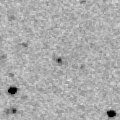
|
Now it is 16.8 mag (Dec. 4, Ken-ichi Kadota). Fading slowly. In the Northern Hemisphere, it stays observable in good condition. It locates somewhat low in the Southern Hemisphere.
Date(TT) R.A. (2000) Decl. Delta r Elong. m1 Best Time(A, h)
Dec. 20 11 21.03 21 15.6 2.061 2.501 104 16.6 5:27 ( 0, 76)
Dec. 27 11 24.61 21 59.6 2.016 2.542 111 16.6 5:03 ( 0, 77)
|

|
Now it is 16.6 mag (Dec. 13, Alfons Diepvens). It stays 17 mag for a while. In the Southern Hemisphere, it will never be observable after this.
Date(TT) R.A. (2000) Decl. Delta r Elong. m1 Best Time(A, h)
Dec. 20 17 47.76 62 46.9 4.500 4.542 86 16.7 5:32 (211, 29)
Dec. 27 18 9.37 62 33.6 4.523 4.560 85 16.7 5:36 (212, 29)
|

|
Now it is 16.5 mag (Dec. 15, Alfons Diepvens). It stays 17 mag for a while. It stays observable in good condition.
Date(TT) R.A. (2000) Decl. Delta r Elong. m1 Best Time(A, h)
Dec. 20 11 6.99 -5 48.4 2.314 2.633 97 16.7 5:13 ( 0, 49)
Dec. 27 11 10.86 -6 42.0 2.244 2.652 103 16.7 4:49 ( 0, 48)
|
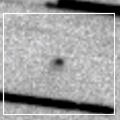
|
It is expected to brighten up to 7 mag in April. Now it is 17.3 mag (Dec. 10, Purple Mountain Observatory, XuYi Station). It will brighten rapidly after this. It will be unobservable soon in the Southern Hemisphere, or in February in the Northern Hemisphere. But it will be observable again in March in the Northern Hemisphere, or in April in the Southern Hemisphere. At the high light, it is observable in the low sky before the perihelion passage in the Northern Hemisphere, or after the perihelion in the Southern Hemisphere.
Date(TT) R.A. (2000) Decl. Delta r Elong. m1 Best Time(A, h)
Dec. 20 22 18.21 22 42.2 2.259 2.295 79 16.9 18:22 ( 73, 61)
Dec. 27 22 15.06 21 23.3 2.287 2.195 72 16.7 18:26 ( 79, 54)
|
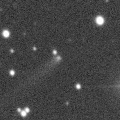
|
Now it is 16.7 mag (Dec. 17, ATLAS Chile). It stays 17 mag for a while. It stays observable in good condition.
Date(TT) R.A. (2000) Decl. Delta r Elong. m1 Best Time(A, h)
Dec. 20 10 51.72 -24 50.8 5.589 5.720 92 16.8 4:58 ( 0, 30)
Dec. 27 10 47.40 -24 52.4 5.493 5.742 99 16.8 4:26 ( 0, 30)
|

|
Now it is 16.9 mag (Nov. 22, Kunihiro Shima). It stays 17 mag for a while. It locates somewhat low in the Northern Hemisphere. In the Southern Hemisphere, it stays observable in good condition.
Date(TT) R.A. (2000) Decl. Delta r Elong. m1 Best Time(A, h)
Dec. 20 9 58.14 -29 55.5 4.202 4.484 100 16.8 4:04 ( 0, 25)
Dec. 27 9 57.78 -30 54.0 4.130 4.488 105 16.8 3:36 ( 0, 24)
|

|
Now it is 16.4 mag (Nov. 27, Andrew Pearce). Fading slowly. It will be fainter than 18 mag in April. It will be unobservable in February in the Southern Hemisphere, or in March in the Northern Hemisphere.
Date(TT) R.A. (2000) Decl. Delta r Elong. m1 Best Time(A, h)
Dec. 20 23 9.19 -2 52.4 2.838 2.824 79 16.8 18:22 ( 27, 49)
Dec. 27 23 16.44 -1 48.1 2.934 2.829 74 16.9 18:26 ( 36, 47)
|

|
Now it is 17.0 mag (Nov. 29, Ken-ichi Kadota). It stays 17 mag for a while. In the Northern Hemisphere, it stays observable in good condition. In the Southern Hemisphere, it will never be observable after this.
Date(TT) R.A. (2000) Decl. Delta r Elong. m1 Best Time(A, h)
Dec. 20 17 19.40 84 60.0 4.691 5.089 108 16.8 5:32 (186, 35)
Dec. 27 18 7.93 84 18.5 4.704 5.089 107 16.8 5:36 (187, 35)
|
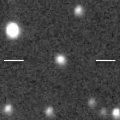
|
Although it is around 20 mag usually, now it is bright in outburst. Now it is 17.2 mag (Nov. 11, ATLAS-HKO, Haleakala). It stays 17 mag for a while. In the Northern Hemisphere, it stays observable in good condition. In the Southern Hemisphere, it will be unobservable in March.
Date(TT) R.A. (2000) Decl. Delta r Elong. m1 Best Time(A, h)
Dec. 20 2 45.11 37 20.2 8.038 8.793 137 17.0 20:49 (180, 88)
Dec. 27 2 43.72 37 5.2 8.101 8.784 131 17.0 20:20 (180, 88)
|

|
Now it is 18.1 mag (Dec. 8, Catalina Sky Survey). Brightening slowly. It will be unobservable in January in the Southern Hemisphere, or in March in the Northern Hemisphere. It will brighten up to 15.5 mag in spring. But it is not observable around the perihelion passage.
Date(TT) R.A. (2000) Decl. Delta r Elong. m1 Best Time(A, h)
Dec. 20 21 53.87 -10 42.5 2.488 2.153 58 17.3 18:22 ( 44, 33)
Dec. 27 22 5.17 -9 17.3 2.519 2.113 54 17.2 18:26 ( 49, 31)
|
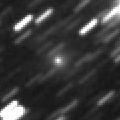
|
Very far object. Now it is 16.6 mag (Oct. 19, ATLAS Chile). It stays 17 mag for a while. In the Northern Hemisphere, it will be unobservable in January. In the Southern Hemisphere, it will be getting lower gradually. But it will be getting higher again after April.
Date(TT) R.A. (2000) Decl. Delta r Elong. m1 Best Time(A, h)
Dec. 20 0 5.41 -52 15.3 11.322 11.087 73 17.2 18:22 ( 2, 3)
Dec. 27 0 4.87 -51 32.0 11.410 11.101 69 17.2 18:26 ( 7, 3)
|

|
It brightened very rapidly, and it became brighter than expected. Now it is 16.5 mag (Dec. 18, A. Sankovich). Fading slowly. It will be fainter than 18 mag in February. In the Northern Hemisphere, it stays observable in good condition. In the Southern Hemisphere, it will be getting lower gradually.
Date(TT) R.A. (2000) Decl. Delta r Elong. m1 Best Time(A, h)
Dec. 20 0 24.70 -4 14.8 3.282 3.523 95 17.2 18:29 ( 0, 51)
Dec. 27 0 28.40 -3 39.7 3.395 3.533 89 17.3 18:26 ( 8, 51)
|

|
It will brighten up to 15 mag from autumn to winter in 2026. Now it is 17.6 mag (Dec. 14, Purple Mountain Observatory, XuYi Station). It stays 17 mag for a while. In the Northern Hemisphere, it stays observable in good condition. It locates somewhat low in the Southern Hemisphere.
Date(TT) R.A. (2000) Decl. Delta r Elong. m1 Best Time(A, h)
Dec. 20 3 29.86 27 13.0 2.060 2.941 147 17.3 21:33 ( 0, 82)
Dec. 27 3 25.10 27 15.3 2.088 2.911 139 17.2 21:01 ( 0, 82)
|

|
Peculiar asteroid moving along a cometary orbit. Now it is 18.1 mag (Oct. 5, ATLAS-HKO, Haleakala). Fading slowly. It will be fainter than 18 mag in March. In the Northern Hemisphere, it stays observable in good condition. It locates somewhat low in the Southern Hemisphere.
Date(TT) R.A. (2000) Decl. Delta r Elong. m1 Best Time(A, h)
Dec. 20 8 6.44 21 39.6 1.642 2.536 148 17.4 2:13 ( 0, 77)
Dec. 27 8 3.91 22 28.7 1.617 2.550 156 17.3 1:43 ( 0, 77)
|

|
Now it is 17.9 mag (Dec. 15, ATLAS South Africa). Fading slowly. It will be fainter than 18 mag in March. It stays observable in good condition.
Date(TT) R.A. (2000) Decl. Delta r Elong. m1 Best Time(A, h)
Dec. 20 9 4.63 0 24.2 3.260 3.940 127 17.3 3:11 ( 0, 55)
Dec. 27 8 57.62 1 55.5 3.188 3.962 136 17.3 2:37 ( 0, 57)
|

|
It brightened up to 8 mag from 2022 summer to 2023 spring. Now it is 17.0 mag (Dec. 1, Alfons Diepvens). It stays 18 mag for a while. In the Northern Hemisphere, it stays observable in good condition. It locates somewhat low in the Southern Hemisphere.
Date(TT) R.A. (2000) Decl. Delta r Elong. m1 Best Time(A, h)
Dec. 20 5 53.41 30 39.1 9.234 10.210 172 17.5 0:01 ( 0, 86)
Dec. 27 5 49.92 30 46.2 9.290 10.259 169 17.5 23:25 ( 0, 86)
|

|
Now it is 16.5 mag (Dec. 14, ATLAS Chile). Fading gradually. It will be fainter than 18 mag in January. It stays observable in good condition.
Date(TT) R.A. (2000) Decl. Delta r Elong. m1 Best Time(A, h)
Dec. 20 3 9.28 4 1.8 2.109 2.902 136 17.5 21:13 ( 0, 59)
Dec. 27 3 7.42 4 38.1 2.207 2.932 129 17.7 20:43 ( 0, 60)
|

|
Now it is 17.8 mag (Nov. 14, W. Hasubick). It stays 18 mag for a while. It stays observable in good condition.
Date(TT) R.A. (2000) Decl. Delta r Elong. m1 Best Time(A, h)
Dec. 20 12 12.57 -10 50.9 5.599 5.528 80 17.7 5:32 (344, 43)
Dec. 27 12 12.10 -10 20.2 5.484 5.542 88 17.6 5:36 (355, 44)
|

|
Now it is 17.2 mag (Nov. 26, Andrew Pearce). It stays 18 mag for a while. It stays extremely low in the Northern Hemisphere. In the Southern Hemisphere, it stays observable in good condition.
Date(TT) R.A. (2000) Decl. Delta r Elong. m1 Best Time(A, h)
Dec. 20 4 56.47 -47 42.4 8.424 8.775 107 17.7 22:59 ( 0, 7)
Dec. 27 4 50.43 -47 25.1 8.493 8.820 106 17.7 22:25 ( 0, 8)
|

|
Now it is 17.7 mag (Nov. 25, ATLAS-MLO, Mauna Loa). Fading slowly. It will be fainter than 18 mag in February. It stays observable in good condition.
Date(TT) R.A. (2000) Decl. Delta r Elong. m1 Best Time(A, h)
Dec. 20 6 57.42 4 49.6 3.319 4.234 155 17.7 1:04 ( 0, 60)
Dec. 27 6 53.40 4 43.1 3.308 4.246 159 17.7 0:33 ( 0, 60)
|

|
NkYk1912JulyIt brightened up to 12.1 mag in early summer (June 10, Taras Prystavski). Now it is 16.4 mag (Dec. 11, Hidenori Nohara). Fading gradually. It will be fainter than 18 mag in January. It stays observable in good condition.
Date(TT) R.A. (2000) Decl. Delta r Elong. m1 Best Time(A, h)
Dec. 20 9 13.73 14 17.3 1.859 2.616 131 17.7 3:20 ( 0, 69)
Dec. 27 9 9.28 15 2.8 1.843 2.671 139 17.8 2:48 ( 0, 70)
|

|
It brightened up to 13.7 mag in last winter (Jan. 4, 2025, W. Pei). It stays 18 mag for a while. It locates somewhat low in the Northern Hemisphere. In the Southern Hemisphere, it will be getting higher gradually.
Date(TT) R.A. (2000) Decl. Delta r Elong. m1 Best Time(A, h)
Dec. 20 14 25.46 -22 5.6 3.705 3.121 47 17.7 5:32 (316, 19)
Dec. 27 14 34.40 -23 0.9 3.649 3.141 52 17.8 5:36 (321, 21)
|

|
Peculiar asteroid moving along a cometary orbit. It brightened up to 17 mag from 2024 to 2025. Now it is 17.8 mag (Oct. 5, ATLAS-HKO, Haleakala). It stays 18 mag for a while. It stays observable in good condition.
Date(TT) R.A. (2000) Decl. Delta r Elong. m1 Best Time(A, h)
Dec. 20 6 27.43 22 21.3 8.301 9.275 171 17.9 0:35 ( 0, 77)
Dec. 27 6 22.81 22 5.9 8.305 9.288 178 17.8 0:03 ( 0, 77)
|

|
It brightened up to 12.1 mag in 2023 spring (May 20, 2023, Jose Guilherme de S. Aguiar). It stays 18 mag for a while. It stays observable in good condition.
Date(TT) R.A. (2000) Decl. Delta r Elong. m1 Best Time(A, h)
Dec. 20 6 15.82 -20 21.8 7.906 8.639 135 17.8 0:23 ( 0, 35)
Dec. 27 6 12.09 -20 5.4 7.945 8.685 136 17.8 23:47 ( 0, 35)
|

|
The condition of this apparition is bad. It must have brightened up to 16 mag in summer, but it was not observable. Fading gradually. It will be fainter than 18 mag soon. It locates somewhat low in the Northern Hemisphere. In the Southern Hemisphere, it will be getting higher gradually.
Date(TT) R.A. (2000) Decl. Delta r Elong. m1 Best Time(A, h)
Dec. 20 14 15.57 -16 31.2 2.653 2.170 50 17.9 5:32 (315, 25)
Dec. 27 14 27.66 -17 33.3 2.623 2.209 54 18.0 5:36 (320, 26)
|

|
It had been lost for 113 years. It passed the perihelion on Dec. 4. It brightened up to 18 mag in outburst in 2007. Brightening slowly. It stays observable in good condition.
Date(TT) R.A. (2000) Decl. Delta r Elong. m1 Best Time(A, h)
Dec. 20 12 4.25 4 20.8 1.247 1.571 88 22.0 5:32 (342, 58)
Dec. 27 12 19.25 2 40.0 1.209 1.582 91 21.9 5:36 (350, 57)
|
|
![]()
 (306173) 2010 NK83
(306173) 2010 NK83 C/2024 X2 ( ATLAS )
C/2024 X2 ( ATLAS ) C/2017 K2 ( PanSTARRS )
C/2017 K2 ( PanSTARRS ) 48P/Johnson
48P/Johnson C/2024 G2 ( ATLAS )
C/2024 G2 ( ATLAS ) C/2019 U5 ( PanSTARRS )
C/2019 U5 ( PanSTARRS ) 276P/Vorobjov
276P/Vorobjov 217P/LINEAR
217P/LINEAR P/2023 S1 ( PanSTARRS )
P/2023 S1 ( PanSTARRS ) (468861) 2013 LU28
(468861) 2013 LU28 C/2020 K1 ( PanSTARRS )
C/2020 K1 ( PanSTARRS ) 60P/Tsuchinshan 2
60P/Tsuchinshan 2 489P/Denning
489P/Denning![]()





















































